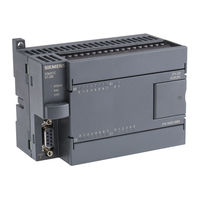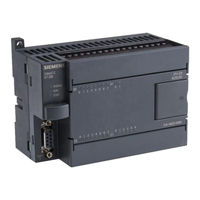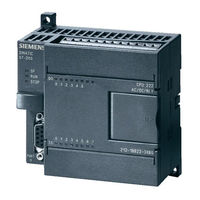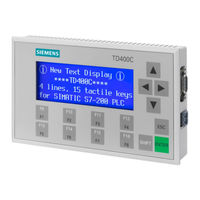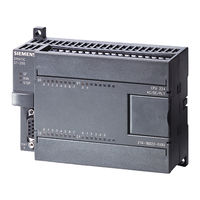Siemens SIMATIC S7-200 Manuals
Manuals and User Guides for Siemens SIMATIC S7-200. We have 16 Siemens SIMATIC S7-200 manuals available for free PDF download: System Manual, Manual, Getting Started, Driver Manual
Siemens SIMATIC S7-200 System Manual (607 pages)
Brand: Siemens
|
Category: Controller
|
Size: 3.7 MB
Table of Contents
Advertisement
Siemens SIMATIC S7-200 System Manual (866 pages)
Brand: Siemens
|
Category: Controller
|
Size: 17.28 MB
Table of Contents
Siemens SIMATIC S7-200 System Manual (726 pages)
Brand: Siemens
|
Category: Controller
|
Size: 15.42 MB
Table of Contents
Advertisement
Siemens SIMATIC S7-200 System Manual (554 pages)
Programmable Controller
Brand: Siemens
|
Category: Controller
|
Size: 4.8 MB
Table of Contents
Siemens SIMATIC S7-200 System Manual (474 pages)
Brand: Siemens
|
Category: Controller
|
Size: 4 MB
Table of Contents
Siemens SIMATIC S7-200 System Manual (482 pages)
Programmable Controller
Brand: Siemens
|
Category: Controller
|
Size: 2.05 MB
Table of Contents
Siemens SIMATIC S7-200 Getting Started (65 pages)
Brand: Siemens
|
Category: Industrial Equipment
|
Size: 2.8 MB
Table of Contents
Siemens SIMATIC S7-200 Manual (49 pages)
Brand: Siemens
|
Category: Controller
|
Size: 3.34 MB
Table of Contents
Siemens SIMATIC S7-200 Manual (75 pages)
Brand: Siemens
|
Category: Controller
|
Size: 3.57 MB
Table of Contents
Siemens SIMATIC S7-200 Manual (55 pages)
Microsystem
Brand: Siemens
|
Category: Controller
|
Size: 5.64 MB
Table of Contents
Siemens SIMATIC S7-200 Manual (30 pages)
software conversion tool
Brand: Siemens
|
Category: Controller
|
Size: 0.32 MB
Table of Contents
Siemens SIMATIC S7-200 Manual (35 pages)
Brand: Siemens
|
Category: Controller
|
Size: 2.29 MB
Table of Contents
Siemens SIMATIC S7-200 Driver Manual (28 pages)
Brand: Siemens
|
Category: Controller
|
Size: 0.4 MB
Table of Contents
Siemens SIMATIC S7-200 Manual (18 pages)
Ethernet Gateway for SIMATIC MPI/ PROFIBUS Driver
Table of Contents
Siemens SIMATIC S7-200 System Manual (20 pages)
Brand: Siemens
|
Category: Industrial Equipment
|
Size: 1.09 MB
Table of Contents
Advertisement
